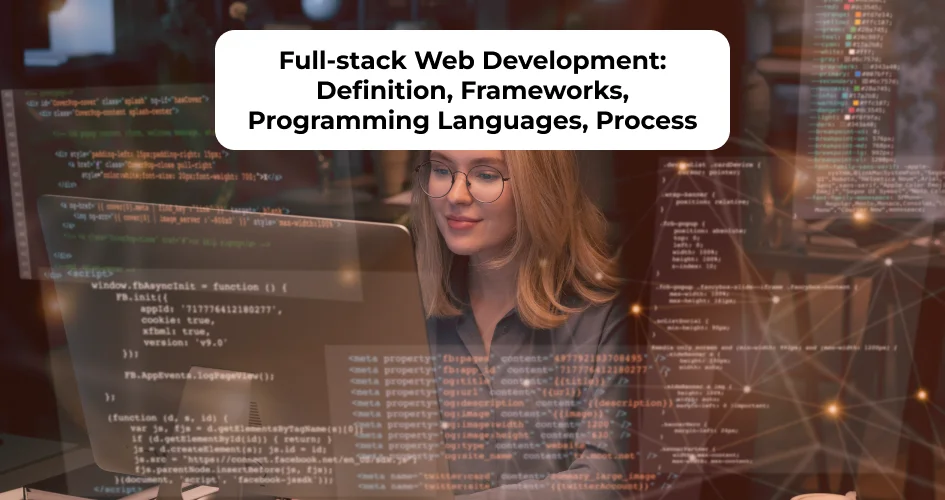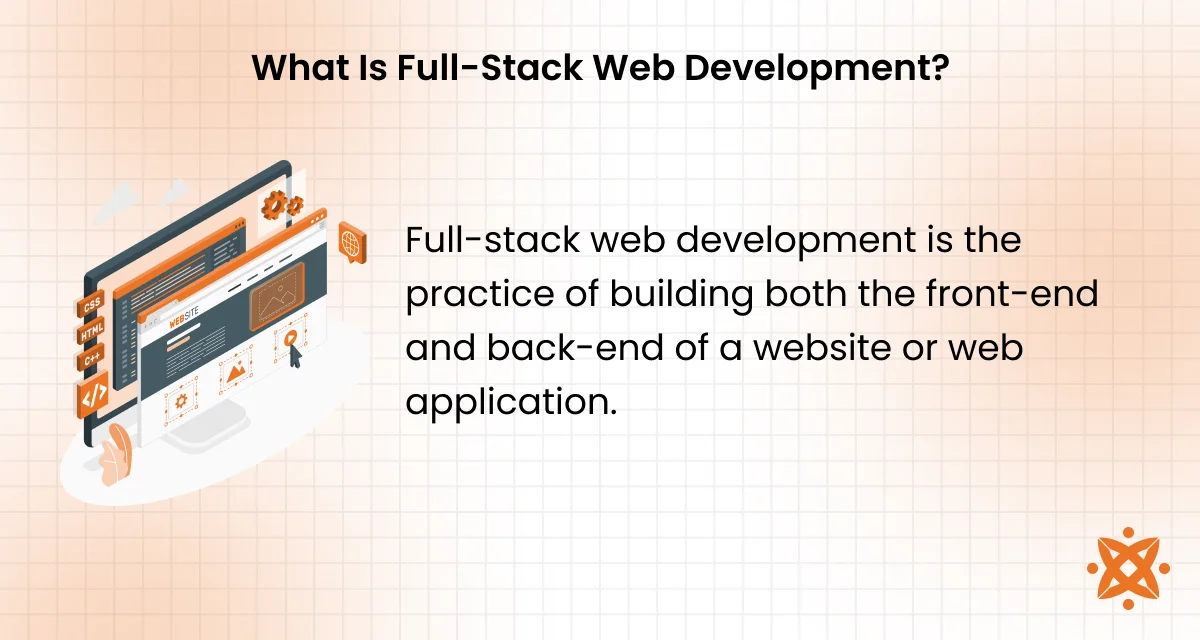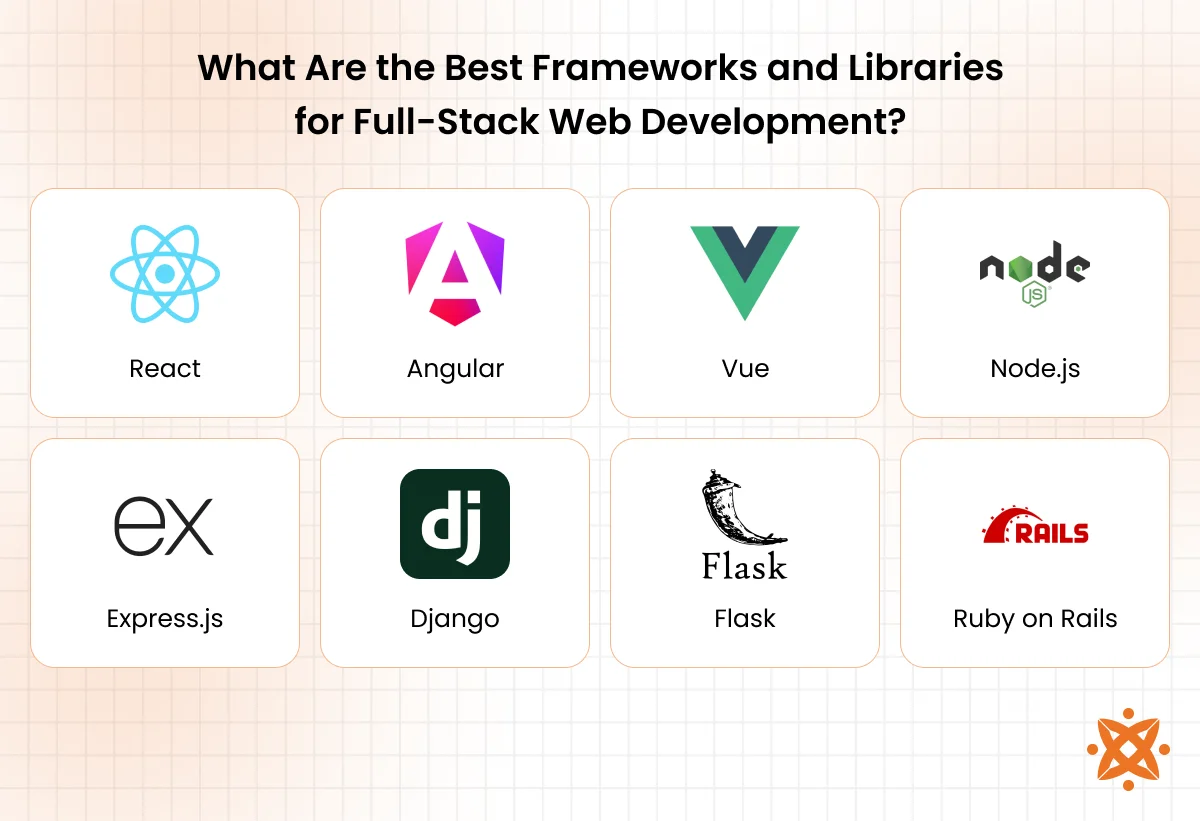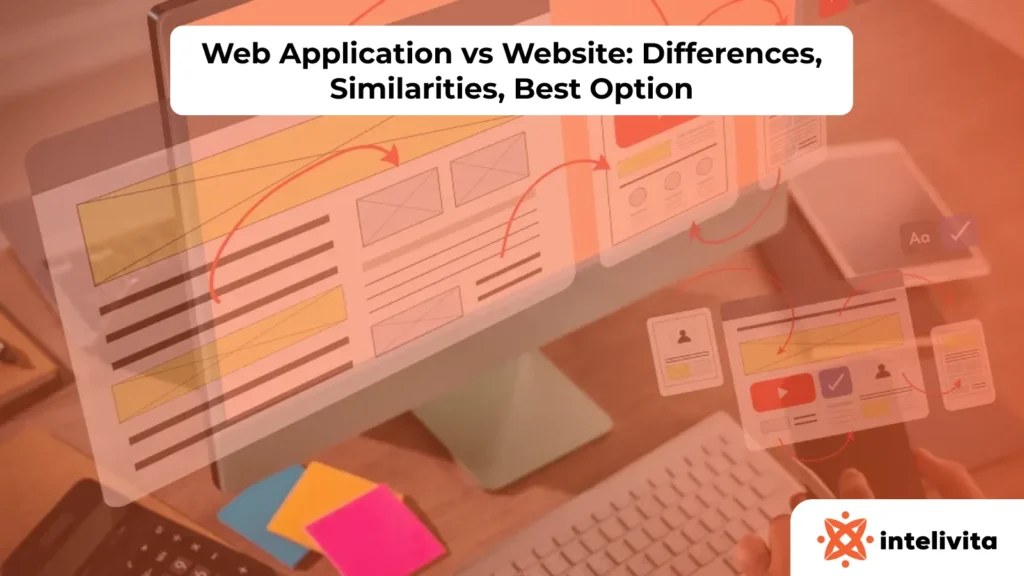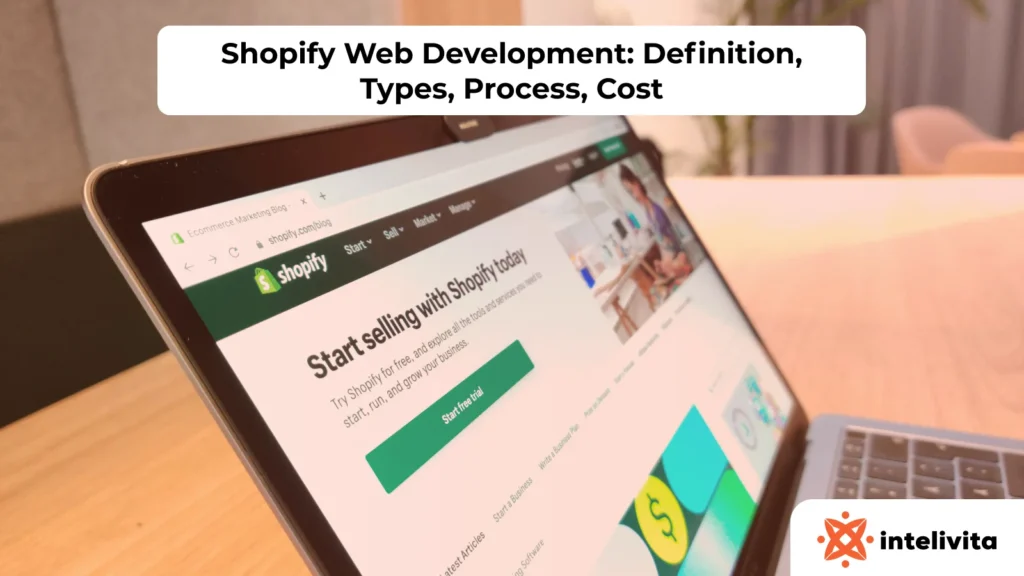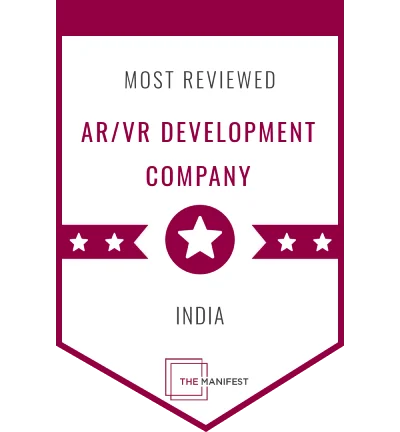Full-stack web development covers both frontend and backend tasks to build dynamic, interactive web applications. It involves handling everything from UI/UX to server logic, APIs, databases, version control, and deployment platforms.
The best frameworks for full-stack development include React, Angular, and Vue for frontend development, paired with Node.js, Express.js, Django, Flask, and Ruby on Rails for the backend. These developer tools help improve speed, scalability, and maintainability across full-stack projects.
Common programming languages in stack development are HTML, CSS, JavaScript, TypeScript, Python, Java, PHP, and SQL. These languages enable full-stack developers to build everything from web interfaces to databases and backend services.
The full stack development process starts with planning, then frontend and backend development, API integration, testing, and deployment using platforms like Vercel, Netlify, or Heroku. Version control (e.g., Git), DevOps tools (Docker, Kubernetes, CI/CD pipelines), and authentication methods (OAuth, JWT, Firebase Auth) are essential along the way.
According to the U.S. Bureau of Labor Statistics, web development jobs, including full-stack roles, are projected to grow 16% from 2022 to 2032, much faster than average.
What Is Full-Stack Web Development?
Full-stack web development is the practice of building both the front-end and back-end of a website or web application. The front end of a website is everything your users interact with, such as buttons, pages, and forms, while the back end is the logic, database, and server-side functionality that powers it all behind the scenes. When one developer or team handles both sides, that’s full-stack development in action.
This web development approach is important because it keeps your project efficient. Instead of having separate teams for front-end and back-end development, a full-stack setup allows everything to move faster and more efficiently. You reduce handoffs, simplify communication, and make it easier to maintain consistency across the entire system.
You’ll find full-stack development behind many of the digital tools we rely on today, including e-commerce stores, social networks, mobile-responsive websites, business dashboards, and SaaS platforms. It’s ideal for startups that need flexibility, businesses looking to scale quickly, or anyone building a product from scratch.
What Is a Full-Stack Web Developer?
A full-stack web developer is someone who builds and maintains both the front-end and back-end of a web application. They understand how everything fits together, from what the user sees on the screen to how data is stored and processed on the server. In short, they’re the bridge between design and functionality.
A full-stack web developer’s day-to-day work involves handling front-end tasks, such as creating responsive layouts with HTML, CSS, and JavaScript frameworks like React or Vue. On the back end, they work with server-side languages such as Node.js, Python, or PHP, manage databases using tools like MongoDB or MySQL, and set up APIs that connect the two ends.
To succeed as a full-stack developer, you should have strong coding skills in both front-end and back-end languages, a solid understanding of databases, and experience with frameworks and libraries used in web development.
A full-stack developer must also be comfortable working with RESTful APIs, basic DevOps tools, and version control systems. Strong problem-solving skills and the ability to see the big picture are just as important as technical know-how.
What Are the Best Frameworks and Libraries for Full-Stack Web Development?
The best frameworks and libraries for full-stack web development are React, Vue.js, Angular, Node.js, Django, Ruby on Rails, and Express.js. They are the best frameworks and libraries for full-stack web development because they offer speed, scalability, and flexibility across both the front end and back end.
The best frameworks and libraries for full-stack web development are explained below:
- React (JavaScript): React is a front-end library developed by Facebook in 2013. It’s designed for building fast, responsive user interfaces using reusable components. Since it’s written in JavaScript, it’s easy to integrate with back-end JavaScript environments like Node.js.
- Angular (TypeScript): Angular is a front-end framework maintained by Google, built with TypeScript, a typed superset of JavaScript. It’s perfect for developing complex, large-scale applications and comes packed with built-in tools, routing, and form handling.
- Vue (JavaScript): Vue is a progressive JavaScript framework introduced in 2014. It’s known for being lightweight and beginner-friendly, offering reactive data binding and component-driven architecture, just like React, but with a simpler learning curve.
- Node.js (JavaScript): Node.js is a back-end runtime environment that enables you to use JavaScript on the server side. It’s ideal for real-time applications like chat apps or streaming platforms. Pairing it with front-end JavaScript tools creates a consistent full-stack experience.
- Express.js (JavaScript): Express.js is a web application framework for Node.js. It’s small, fast, and minimalist, perfect for building APIs or microservices. Since it runs on JavaScript, it’s a natural fit alongside React or Vue on the front end.
- Django (Python): Django is a full-featured back-end framework built with Python. It’s ideal for developers who want a secure and scalable setup with numerous built-in features. Django is commonly used for content-heavy platforms and admin dashboards.
- Flask (Python): Flask is a micro-framework also written in Python. It’s more lightweight than Django and gives you full control over your app’s structure. Flask is used for smaller projects or when you need a simple back-end API.
- Ruby on Rails (Ruby): Ruby on Rails is a full-stack framework that uses the Ruby programming language. It emphasizes convention over configuration, which helps you build applications quickly without needing to manually set up every small detail.
What Programming Languages are Used for Full-Stack Web Development?
The main programming languages used for full-stack web development include JavaScript, Python, Ruby, PHP, and TypeScript. JavaScript is the most widely used because it powers both front-end (with frameworks like React or Vue) and back-end (with Node.js) development.
The main programming languages used for the full-stack web are explained below:
- HTML: HTML (HyperText Markup Language) is the backbone of every web page. It defines the structure of content, such as headings, paragraphs, links, and images. It’s not a programming language, but without it, nothing displays in the browser. It’s simple to learn, but limited to layout and structure only.
- CSS: CSS (Cascading Style Sheets) controls the look and feel of a website, colors, fonts, spacing, and responsiveness. It works in conjunction with HTML to create visually appealing interfaces. While powerful, managing large CSS files can become complex without good structure or frameworks like Tailwind or Bootstrap.
- JavaScript: JavaScript powers interactivity on the front end, like dropdowns, sliders, and dynamic content. It’s also used on the back end with Node.js, making it a true full-stack language. It’s fast and versatile, but gets messy in large codebases if not well-organized.
- TypeScript: TypeScript is a superset of JavaScript that adds static typing. It helps catch errors early and makes large applications easier to manage. The learning curve is slightly higher than plain JavaScript, but it pays off in larger, more complex projects.
- Python: Python is a clean, readable language used for back-end development with frameworks like Django and Flask. It’s beginner-friendly and great for rapid development. However, it’s slower than some other languages and is not used for front-end development.
- Java: Java is a robust, object-oriented language commonly used in enterprise-level back-end development. It offers strong security and cross-platform capabilities. On the downside, Java apps are more memory-intensive and require more setup.
- PHP: PHP is a server-side scripting language widely used for web development, particularly with platforms like WordPress. It’s easy to get started with, but older PHP codebases are hard to maintain. Still, modern PHP frameworks like Laravel have improved its reputation.
- SQL: SQL (Structured Query Language) is used to manage and query databases. It works behind the scenes to handle data in apps, like user info, orders, or messages. It’s powerful for data handling, although it’s limited to database operations and requires pairing with another language.
What DevOps tools are used for Full-stack Web development?
The main DevOps tools used for full-stack web development include Git, Docker, Jenkins, GitHub Actions, and Kubernetes. These tools help automate workflows, manage code versions, test applications, and deploy them reliably across different environments.
The DevOps tools used for full-stack web development are explained below:
- Docker: Docker is a containerization tool that allows you to package your application and all its dependencies into a single unit. It ensures that your app runs the same way on every machine, whether it’s your laptop, a test server, or a production server. It’s fast, lightweight, and simplifies environment management, but it gets complex when dealing with large-scale container networks.
- Kubernetes: Kubernetes is an open-source platform for managing and scaling containerized applications. It automates deployment, scaling, and load balancing for containers like those created with Docker. It’s ideal for large, distributed systems, but it has a steep learning curve and requires solid DevOps knowledge.
- CI/CD Pipelines: Continuous Integration and Continuous Deployment (CI/CD) pipelines are automated workflows that test, build, and deploy code every time changes are made. Tools like GitHub Actions, Jenkins, and GitLab CI help you catch errors early and speed up releases. While CI/CD makes your team more efficient, setting up and maintaining the pipeline takes upfront time and planning.
What Are the Popular Tech Stacks Used in Full-Stack Web Development?
The main tech stacks used for full-stack web development include the MERN stack (MongoDB, Express.js, React, Node.js), MEAN stack (MongoDB, Express.js, Angular, Node.js), and LAMP stack (Linux, Apache, MySQL, PHP). When building a full-stack application, tech stacks offer a ready-made combination of tools that work well together from front to back.
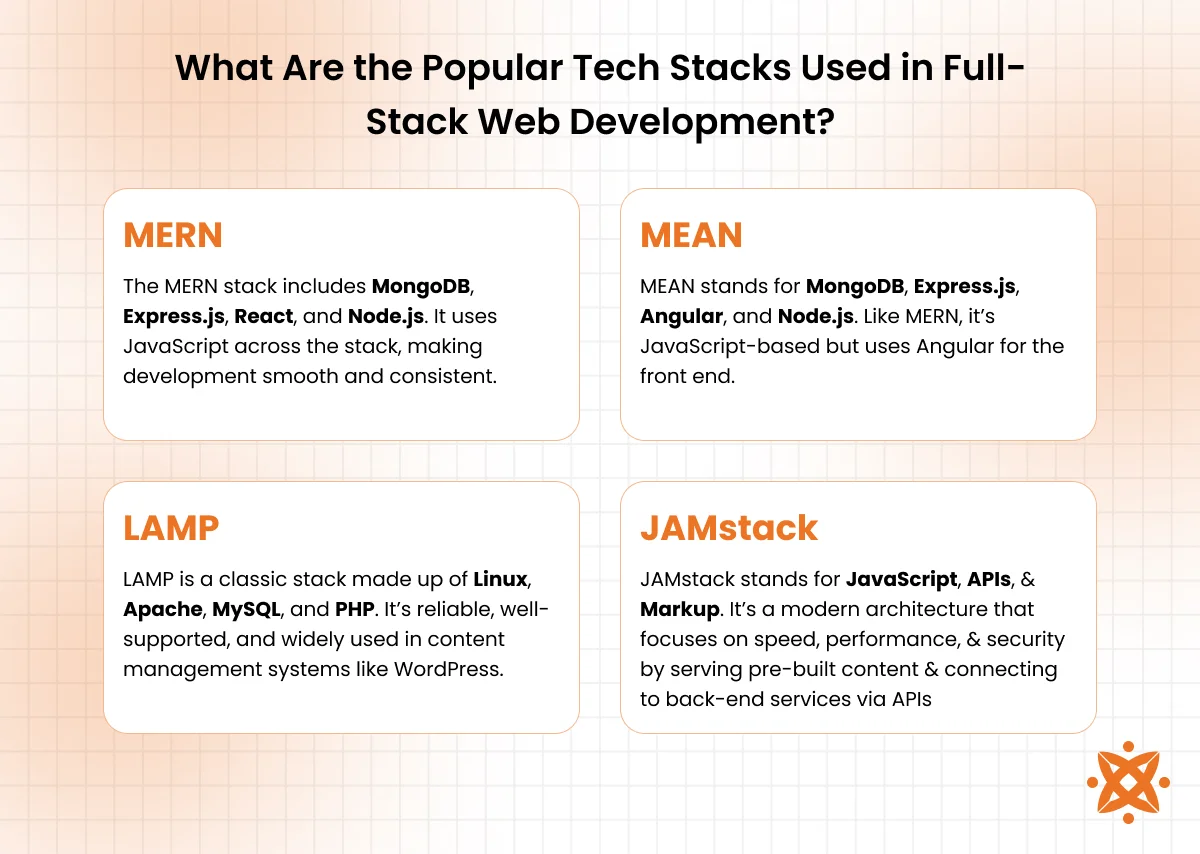
Here are the popular tech stacks used in full-stack web development:
- MERN: The MERN stack includes MongoDB, Express.js, React, and Node.js. It uses JavaScript across the stack, making development smooth and consistent. It’s great for building modern single-page applications. However, MongoDB’s flexibility leads to inconsistent data if not properly managed.
- MEAN: MEAN stands for MongoDB, Express.js, Angular, and Node.js. Like MERN, it’s JavaScript-based but uses Angular for the front end. It’s ideal for enterprise-scale applications, but Angular has a steeper learning curve compared to React or Vue.
- LAMP: LAMP is a classic stack made up of Linux, Apache, MySQL, and PHP. It’s reliable, well-supported, and widely used in content management systems like WordPress. Its downside is that it’s not as modern or flexible for building highly interactive, JavaScript-heavy apps.
- JAMstack: JAMstack stands for JavaScript, APIs, and Markup. It’s a modern architecture that focuses on speed, performance, and security by serving pre-built content and connecting to back-end services via APIs. It’s perfect for static sites and headless CMSs, but not ideal for projects that require complex, real-time functionality.
How is Full-Stack Web Development Done?
To execute a full-stack web development project, design the front-end interface, build the back-end, connect it to a database, and link everything together using APIs. Full-stack web development involves several key steps that bring both the user interface and server logic together into one smooth application.
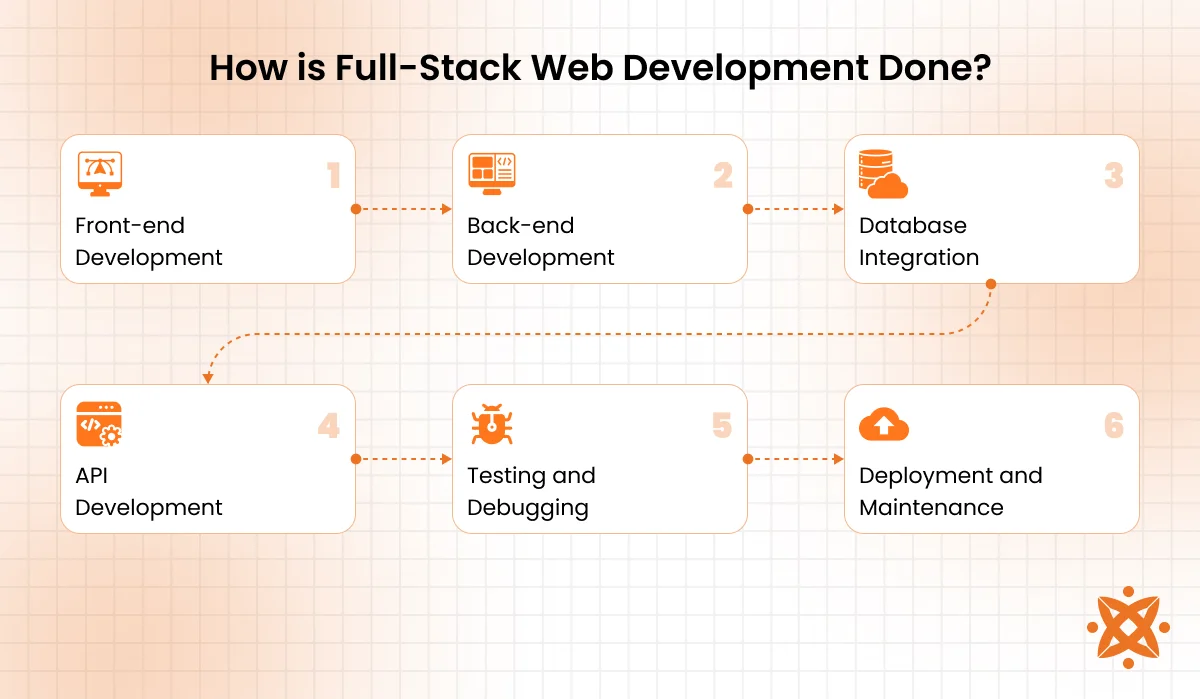
Here’s how a full-stack web development is done:
1. Front-end Development
The process starts with building the front end, the part of the website users interact with. Developers use HTML for structure, CSS for design, and JavaScript frameworks like React, Vue, or Angular for interactivity. This step focuses on creating a responsive, user-friendly experience across devices.
2. Back-end Development
Next is setting up the back end, the server, application, and database that handle business logic and data management. Tools like Node.js, Django, Flask, or PHP are used to build the logic that powers the app. The goal here is to process requests, store data, and manage user sessions securely and efficiently.
3. Database Integration
A database is added to store and retrieve data such as user accounts, orders, or content. Common options include MongoDB, MySQL, and PostgreSQL. The developer creates models and queries to interact with the data based on how the application works.
4. API Development
APIs (Application Programming Interfaces) are created to connect the front end to the back end. They enable the two sides to communicate with each other, allowing them to send and receive data. RESTful APIs or GraphQL are used, depending on the project’s complexity.
5. Testing and Debugging
Before launch, the entire application goes through testing to catch bugs and ensure everything works as expected. This includes unit tests, integration tests, and user testing. Developers also debug issues that pop up and optimize performance.
6. Deployment and Maintenance
Once everything is ready, the application is deployed to a live server using platforms like Vercel, Heroku, AWS, or DigitalOcean. Continuous integration and deployment (CI/CD) tools help automate future updates. After launch, the developer monitors performance and rolls out improvements as needed.
What is the Difference Between Full-Stack Web Development and Front-end Web Development?
The main difference between full-stack web development and front-end web development is the scope of work involved. Full-stack developers handle both the front end (what users see) and the back end (how the application works behind the scenes). In contrast, front-end web development focuses only on designing and coding the user interface.
Beyond that, full-stack developers must understand server-side logic, database integration, and APIs, whereas front-end developers specialise in layout, responsiveness, user experience, and browser performance. In essence, the front end is just one part of what full-stack developers manage in a broader development process.
What is the Difference Between Full-Stack Web Development and Back-end Web Development?
The main difference between full-stack web development and back-end web development is that full-stack covers both the front-end and back-end of a web application, while back-end development focuses strictly on the server side.
Full-stack web development builds the entire system end-to-end, while back-end web development is responsible for everything behind the scenes, like servers, databases, and APIs.
Full-stack developers require knowledge of user interface tools in addition to server-side logic, whereas back-end developers focus on handling data processing, authentication, and system architecture. In short, the full stack is broader, while the back end is deeper in its specific area.
How is Full-Stack Web Development Different from General Web Development?
The main difference between full-stack web development and general web development is specialization. Full-stack developers are skilled in both front-end and back-end technologies, while general web developers focus on just one area, either building the visual interface or managing server-side tasks.
Full-stack development demands a wider skill set and the ability to move between layers of a project, whereas general web development involves working within a specific role or collaborating with other specialists.
Simply put, full-stack developers handle the full process, while general developers contribute to specific parts.
What Is the Difference Between Full Stack Developer and Web Developer?
The main difference between a full-stack developer and a web developer is the range of responsibilities. A full-stack developer builds and manages both the front-end and back-end of a web application, while a web developer focuses on just one, usually either the visual interface or the server-side logic.
Full-stack developers are expected to understand how all layers of a project connect and communicate, which makes them more versatile in smaller teams or fast-moving projects. Web developers, on the other hand, specialise in one area and work as part of a larger development team.
How to Choose the Right Full-stack Web Developer for Your Project?
To choose the right full-stack web developer for your project, look for someone with hands-on experience in both front-end and back-end technologies that match your tech stack. Make sure they can communicate clearly, understand your business goals, and have a strong portfolio of similar projects.
Here are key tips to choose the right full-stack web developer for your project:
- Check technical expertise: Make sure the developer is comfortable with both front-end (HTML, CSS, JavaScript) and back-end (Node.js, Django, etc.) technologies.
- Review past projects: Look at their portfolio to see if they’ve built applications similar to what you need.
- Assess communication skills: They should be able to explain technical concepts clearly and collaborate smoothly with your team.
- Evaluate problem-solving ability: Ask how they’ve handled challenges in past projects and if they can adapt to changing requirements.
- Ask about deployment and maintenance experience: A good full-stack developer should understand DevOps basics and know how to manage post-launch updates.
- Check for long-term support: Ensure they’re available for ongoing maintenance and improvements after launch.
Looking for a trusted web development service? Consider Intelivita for full-stack web development services near you. Their developers are highly experienced, business-focused, and flexible across different tech stacks. Plus, they offer end-to-end support from concept to launch and beyond.
What Is The Cost Of Full-Stack Web Development?
The average cost of full-stack web development ranges from $5,000 to $50,000 or more, depending on the complexity, features, and scope of the project. Simple websites with basic functionality cost much less than enterprise platforms, e-commerce sites, or custom web apps with advanced integrations.
Factors that influence the cost include the number of pages, required technologies, design complexity, development timeline, and whether you’re hiring freelancers or a full-service agency. Maintenance, hosting, and ongoing updates can also add to the total cost over time.
What Are The Best Practices For Full-Stack Web Development?
The best practices for full-stack web development include writing modular code, using version control like Git, and securing both front-end and back-end components. Following best practices ensures your web application is fast, secure, scalable, and easy to maintain.
Here are the best practices for full-stack web development to follow:
- Plan Before You Build: Start with clear project goals, wireframes, and architecture before writing code.
- Use Version Control: Always use Git or another version control system to track changes and collaborate effectively.
- Keep Code Modular: Break your application into reusable components and modules to make it easier to manage and scale.
- Follow Consistent Naming Conventions: Use clear and consistent naming patterns for files, functions, and variables.
- Secure Your Application: Sanitise inputs, protect APIs, and implement proper authentication and authorisation practices.
- Test Everything: Write unit, integration, and end-to-end tests to catch bugs early and ensure long-term stability.
- Optimise for Performance: Minimise code, compress files, and utilise caching to accelerate load times.
- Use Environment Variables: Store sensitive configuration settings in environment variables instead of hardcoding them.
- Document Your Code and Setup: Provide clear documentation for future developers and for easier maintenance.
- Stay Updated: Regularly update frameworks, libraries, and dependencies to patch vulnerabilities and access new features.
What Are The Emerging Trends In Full-Stack Web Development In 2025?
The emerging trends in full-stack web development in 2025 include AI-powered tools, serverless architecture, JAMstack expansion, and WebAssembly. These tools, technologies, and approaches improve speed, flexibility, and user experience
The emerging trends in full-stack web development in 2025 are as follows:
- AI-Powered Development Tools: Platforms like GitHub Copilot and AI code assistants are helping developers write cleaner code faster by automating repetitive tasks and offering real-time suggestions.
- Serverless Architecture: Developers are shifting toward serverless platforms like AWS Lambda and Vercel to reduce infrastructure management and scale apps more efficiently.
- JAMstack Expansion: JAMstack is evolving with more support for dynamic features via APIs and edge functions, making static sites more interactive and scalable.
- WebAssembly (Wasm): WebAssembly is gaining traction for running high-performance code (like C++ or Rust) in the browser, opening doors to more complex web applications.
- Micro Frontends: Teams are breaking down the front end into smaller, independent modules, allowing faster updates and easier scaling of large applications.
- Low-Code and No-Code Integration: Full-stack workflows are now blending with low-code tools, enabling faster prototyping and reducing manual work for repetitive features.
What Is Full Stack Software Development?
Full-stack software development is the process of building and managing both the client-side (front-end) and server-side (back-end) components of a software application. It covers everything from the user interface and user experience to server logic, databases, APIs, and deployment.
Unlike traditional web development, which focuses only on websites, full-stack software development applies to a broader range of software products. This range includes web applications, mobile applications, and even desktop solutions, all built and maintained by a single developer or team across the entire tech stack.

